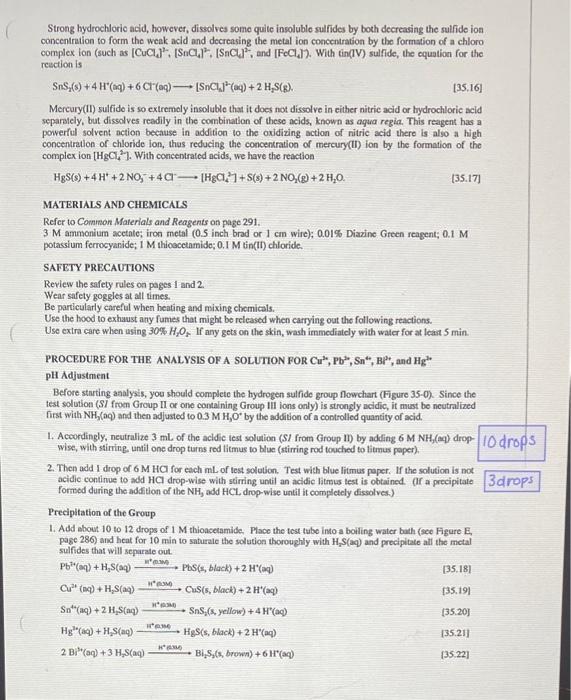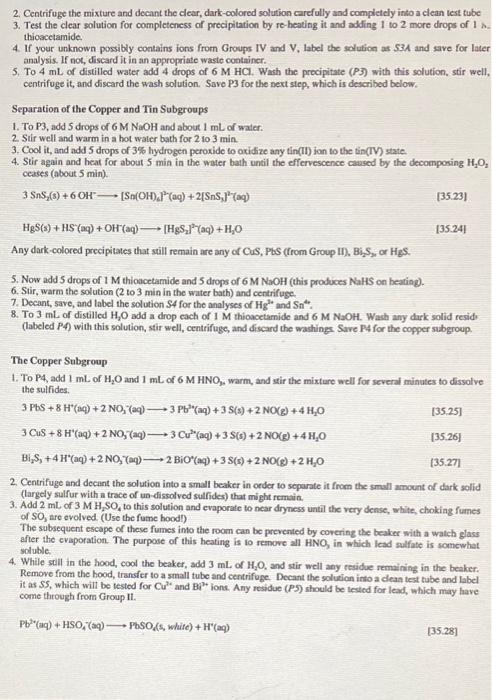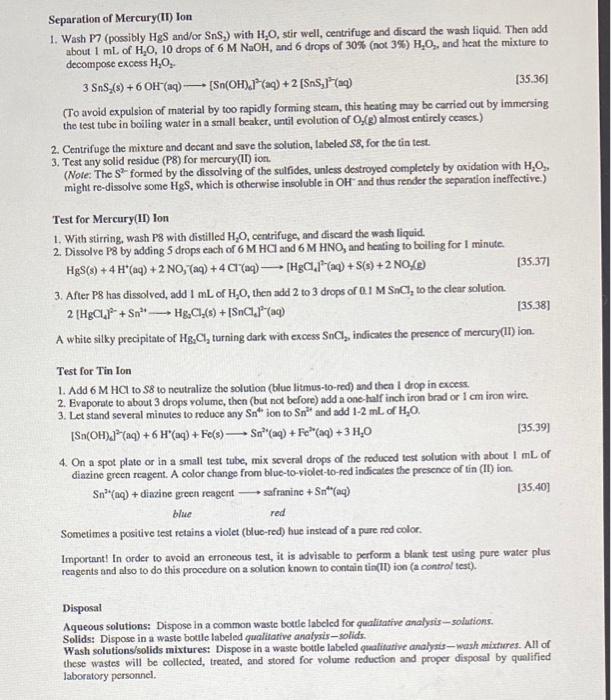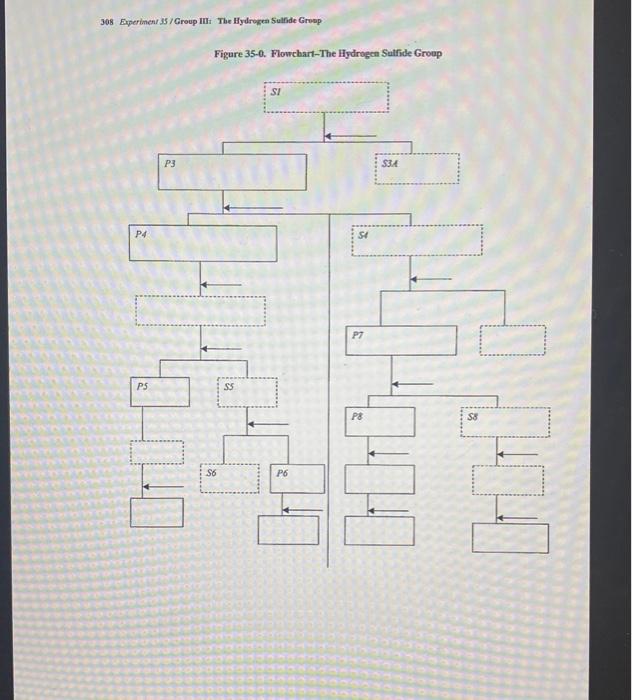Answered step by step
Verified Expert Solution
Question
1 Approved Answer
Help with filling out flowchart below. All information about the lab is in the images. Strong hydrochlorie acid, however, dissolves some quite insoluble sulfides by
Help with filling out flowchart below. All information about the lab is in the images. 




Strong hydrochlorie acid, however, dissolves some quite insoluble sulfides by both decreasing the sulfide ion concentration to form the weak acid and decreasing the metal ion concentration by the formation of a chloro complex ion (such as [CuCl4]2,[SnCl4]2. [SaCl42, and [FeCl4] ). With tin(IV) sulfide, the equation for the resction is SnS2(s)+4H2(aq)+6Cr2(aq)[SnCl3]2(aq)+2H2S(g) Mercury(II) sultide is so extremely insoluble that it does not dissolve in either nitric acid or hydrochloric acid sepantely, but dissolves readily in the combination of these acids, known as agua regia. This reagent has a powerful solvent netion bectuse in addition to the oxidizing action of nitric acid there is also a high concentration of chloride Ion, thas reducing the concentration of mercury(Ii) ion by the formation of the complex ion [HgCl42]. With concentrated acids, we have the reaction HgS(s)+4H++2NO3+4Cl[HgCl42]+S(s)+2NO2(g)+2H2O MATERIALS AND CHEMICALS Refer to Common Materials and Reagents on page 291. 3M ammonium acetale; iron metal (0.5 inch brad or 1cm wire );0.01% Diaxine Green reagent; 0.1M potassium ferrocyaride; 1M thioacetamide; 0.1M tin(ti) chloride. SAFETY PRECAUTIONS Review the safety rules on pages 1 and 2. Wear safety goggles at all times. Be particularly careful when heating and mixing chemicals. Use the hood to exhaust any fumes that might be released when carrying out the following reactions. Use exira care when asing 30%H2O2. If any gets on the skin, wash immediatcly with wate for at leait 5 min. pH Adjustment Before starting aaalysis, you should complete the hydrogen sulfide group flowchart (Figure 35-0). Since the test solution (SI from Group II or one containing Group III lons only) is strongly acidic, it must be neutralized first with NH3(aq) and then adjusted to 0.3MH3O by the addition of a controlled quantity of acid. 1. Aceordingly, neutralize 3mL of the acidic iest solution (Sl from Group II) by adding 6MNH, (aq) dropwise, with stirring, until one drop turns red litmus to blue (stirring rod touched to litmus paper). 2. Then add I drop of 6MHC for each mL of test solution. Test with blue litmus paper. If the solution is not acidic continue to add HCl drop-wise with stirning until an acidic litmos test is obtained. Of a precipitate formed during the addition of the NH3 add HCL, drop-wise until it completely dissolves) Precipltation of the Group 1. Add about 10 to 12 drops of 1M thioacetamide. Place the test tube into a boiling water bath (see Figare E, page 286) and heat for 10 min to saturale the solution thoroughly with HZS (aq) and precipitate all the metal sulfides that will separate out. Pb++(aq)+H2S(aq)M+pamPbS(s,black)+2H+(aq)[35,18]Cu24(mq)+H2S(aq)N+eswCuS(s,black)+2H(aq)[35,19]Sn44(aq)+2H2S(aq)14man+SnS2(s,yellow)+4H+(aq)[3.2.2)Hg3(aq)+H2S(aq)Heme2HgSS(s,black)+2H(aq)[35.21}2Bi4(aq)+3HS(aq)K+easBi4S2(s2brown)+6H+(aq) 2. Centrifuge the mixture and decant the clear, dark-colored solution caref ully and completely into a clean test tube 3. Test the clear solution for completeness of precipitation by re-henting it and adding 1 to 2 more drops of 1k. thioscetamide. analysis. If not, fiscard it in an appropriate waste container. 5. To 4mL of distillod water add 4 drops of 6MHCl. Wash the procipitate (P3) with this solution, stir well. centrifuge it, and discard the wash solution. Save P3 for the next step, which is described below. Separation of the Copper and Tin Subgroups 1. To P3, add 5 drops of 6MNaOH and about 1mL of water. 2. Suir well and warm in a hot water bath for 2103min. 3. Cool it, and add 5 drops of 3% hydrogen peroxide to oxidize any tin(II) ion to the tin(IV) state. 4. Stir again and heat for about 5mia in the weter bath until the effervescence cassed by the decomporing H2O2 ceases (about 5 min). 3SnS2(s)+6OH[Sn(OH)d]2(aq)+2[SnS3]2(aq) HgS(s)+HS(aq)+OH(aq)[HgS2]2(aq)+H2O Any dark-colored precipitates that still remain are any of CuS, PbS (from Group II), Bi, S, or HgS. 5. Now add 5 drops of 1M thicacetamide and 5 drops of 6MNaOH (this produces NaHS on beating). 6. Stir, warm the solution ( 2 to 3min in the water bath) and centrifuge. 7. Decant, save, and label the solution S4 for the analyses of Hglt and Sn4*. 8. To 3mL of distilied H2O add a drop each of 1M thioacetamide and 6MNaOH. Wash any dark solid residr (tabeled P4) with this solution, stir well, centrifuge, and discard the washinge. Save P4 for the copper subgroup. The Copper Subgroup 1. To P4, add 1mL of H2O and 1mL of 6MHNO3, warm, and sir the mixture well for several minutes to dissolve the sulfides. 3PbS+8H(aq)+2NO2(aq)3Pb(aq)+3S(s)+2NO(g)+4H1O3CuS+8H(aq)+2NO3(aq)3Cu2(aq)+3S(s)+2NO(g)+4H2OBi2S3+4H2(aq)+2NO3(aq)2BiO2(aq)+3S(s)+2NO(g)+2H2O [35,25] [35.26] 2. Centrifuge and decant the solution into a smalt beaker in oeder to scparate it from the small amount of dark solid (largely sulfur with a trace of un-dissolved sulfides) that might remain. 3. Add 2mL of 3MH2SO4 to this solution and evaporate to near dryness until the very dense, ahite, chokiag furnes of SO3, tre evolved (Use the fume hoodI) The subsequent escape of these fumes into the room can be prevented by corering the beaker with a watch glass after the cvaporation. The purpose of this heating is to remove all HNO, in which lead sulfate is somewhat soluble. 4. While sall in the hood, cool the beaker, add 3mL of H2O,and stir well any reaidue remaining in the beaker. Remove from the hood, transfer to a small tube and centrifuge. Decant the solution into a cleaa test tube and label it as SS, which will be tested for Cu2 and BP2+ ions. Any residue (PS) should be lested for lead, which may have come through from Group It. Pb2(aq)+HSO4(aq)FhSO4(s,whitc)+H(aq) [35.28] Test for Lead Ion PbSO4(s)+2C2H3O2(aq)Pb2(C2H3O2)2(aq)+SO42(aq)Pb2(C2H3O2)2(aq)+CrO42(aq)PbCrO4(s2yellow)+2C2H2O22(aq) To P5, add 1mL of 3M ammonium acetate, NH4C2H3O2, stir and warm if necescary, to dissolve any lead sulfate. Add 1mL of 1MK2CrO4 and centrifuge. A yellow precipitate proves that lead ion is present. Test for Copper(II) Ion 1. To S5, add encugh 6MNH,(aq) to make the solution distincily basic. The appearance of a darker blue-violet color of [Cu(NH3)]2 in the solution, S6, proves the presence of Cu2. Cu2(aq)+4NH3(aq)[Cu(NH3)]2(aq,deepblue)BiO+(aq)+NH3(aq)+H2OBiO(OH)(5,white)+NH4(aq) 2. If there is a precipitate, centrifuge, save and label it as P for the bismuth test. Test for Bismuth Ion 2BiO(OH)(s)+3Sn(OHH)(aq)+3OH(aq)+2H2O2Bi(s,black)+3InnO(OH)]2(aq) To P6, add one drop each of 6MNaOH and 0.1MSnCl, stir well and centrif uge. The appearance of a grayblack color, Bi, in the residue proves that bismuth ion is present. Precipitation of the Tin Subgroup 1. (Work under the hood.) To solution S4, which is strongly basic and contains S2, add enough 3MH2SO4 drop by drop to neutralize the solution (blue litmus-to-red), stirring yell after the addition of each drop. Note the total volume of acid used. Mix well, but be cautious, or the H2S may be evolved too rapidiy. As long as H2S is evolved rapidly on the addition of each drop of H2SO4, the solution is still basic. 2. After the solution has been neutralized add an excess of 3MH2SO4 equal to one-third the volume of H/, SO4 needed for neutralization." [SnS3]2(aq)+2H+(aq)SnS2(s)+H2S(aq)[HgS2]2(aq)+2H(aq)HgSg(s)+H2S(aq) [35.34] 3. Centrifuge, decant, and diseard the solution, 57 , into the appropriate waste container. A dark or colored precipitale (P7) indicates the presence of the tin subgroup, If the residue is white or very pale yellow, it. probably is sulfur, formed by the decompocition of some S2 ion present. "Since HSO4- in a weak acid OKa=12102, a alight exers of H2SO4 reacts with some of the SO42 feemed H2SO4+SO422HSO4 so that the acidity is repressed by a buffering action. Widh one-thied exceas acid, the SO42 and HSO4conceetutioes will be aboot squal, 20 that HSO41]1.4MSO2]=12102 [H+]=1.2102MA. This in not sufficient [H+]to dissolve the HE,SeS2 precipitate. Separation of Mercury(II) Ion 1. Wash P7 (possibly HgS and/or SnS2 ) with H2O, stir well, centrifuge and discard the wash liquid. Then add about 1mL of H2O,10 drops of 6MNaOH, and 6 drops of 30% (not 3% ) H2O2, and heat the mixture to decompose excess H2O2. 3SnS2(s)+6OH(aq)[Sn(OH)6]2(aq)+2[SnS3]2(aq) [35.36] (To avoid expulsion of material by too rapidly forming steam, this heating may be carried out by immersing the lest tube in boiling water in a small beaker, until evolution of O2 (g) almost entirely ceases) 2. Centrifuge the mixture and decant and save the solution, labeled S8, for the tin test. 3. Test any solid residue (P8) for mercury(II) ion. (Note: The S2 formed by the dissolving of the sulfides, unless destroyed completely by axidation with H2O2, might re-dissolve some HgS, which is otherwise insoluble in OHand thus render the separation ineffective.) Test for Mercury(II) lon 1. With stirring, wash P8 with distilled H2O, centrifuge, and discard the wash liquid. 2. Dissolve P8 by adding 5 drops each of 6MHC and 6MHNO, and heating to boiling for 1 minute. HgSS(s)+4H+(aq)+2NO3(aq)+4Cr(aq)[HgCl1]2(aq)+S(s)+2NO2(g) 3. After P8 has dissolved, add ImL of H2O, then add 2 to 3 drops of 0.1MSnCl2 to the clear solution. 2[H8Cl4]2+Sn24Hg2Cl2(s)+[SnCl6]2(aq) A white silky precipitale of Hg2Cl2 turning dark with excess SnC2, indicates the presence of mercury (II) ion. Test for Tin Ion 1. Add 6MHCl to S8 to neutralize the solution (blue litmus-to-red) and then 1 drop in excess. 2. Evaporate to about 3 drops volume, then (but not before) add a one half inch iron brad or 1cm iron wire. 3. Let stand several minutes to reduce any Sn4 ion to Sn24 and add 12mL of H2O. [Sn(OH)6]2(aq)+6H(aq)+Fe(s)Sn2(aq)+Fe2(aq)+3H2O 4. On a spot plate or in a small test tube, mix several drops of the reduced test solution with about 1mL of diazine green reagent. A color change from blue-to-violet-to-red indicales the presence of tin (II) ion. Sn2+(aq)+diazinegreenreagentsafranine+Sn4(aq) [35,40] blue red Sometimes a positive test retains a violet (blue-red) hue instead of a pure red color. Important! In order to avoid an erroncous test, it is advisable to perform a blank test using pure water plus reagents and also to do this procedure on a solution known to contain tin(II) ion (a control test). Disposal Aqueous solutions: Dispose in a common waste botlle labcied for qualitative analyas-solutions. Solids: Dispose in a waste botle labeled qualitarive analysis - solids. Wash solutions/solids mixtures: Dispose in a waste bottle habeled quealitative analysis - wash mixtires. All of these wastes will be collected, treated, and stored for volume reduction and proper disposal by quelified laboratory personnel. 308 Experinent 35/1 Croup IIIt The Hydrogea Sulfide Groop Figure 35-0. Flowcbart-The Hydrogen Sutfide Group Strong hydrochlorie acid, however, dissolves some quite insoluble sulfides by both decreasing the sulfide ion concentration to form the weak acid and decreasing the metal ion concentration by the formation of a chloro complex ion (such as [CuCl4]2,[SnCl4]2. [SaCl42, and [FeCl4] ). With tin(IV) sulfide, the equation for the resction is SnS2(s)+4H2(aq)+6Cr2(aq)[SnCl3]2(aq)+2H2S(g) Mercury(II) sultide is so extremely insoluble that it does not dissolve in either nitric acid or hydrochloric acid sepantely, but dissolves readily in the combination of these acids, known as agua regia. This reagent has a powerful solvent netion bectuse in addition to the oxidizing action of nitric acid there is also a high concentration of chloride Ion, thas reducing the concentration of mercury(Ii) ion by the formation of the complex ion [HgCl42]. With concentrated acids, we have the reaction HgS(s)+4H++2NO3+4Cl[HgCl42]+S(s)+2NO2(g)+2H2O MATERIALS AND CHEMICALS Refer to Common Materials and Reagents on page 291. 3M ammonium acetale; iron metal (0.5 inch brad or 1cm wire );0.01% Diaxine Green reagent; 0.1M potassium ferrocyaride; 1M thioacetamide; 0.1M tin(ti) chloride. SAFETY PRECAUTIONS Review the safety rules on pages 1 and 2. Wear safety goggles at all times. Be particularly careful when heating and mixing chemicals. Use the hood to exhaust any fumes that might be released when carrying out the following reactions. Use exira care when asing 30%H2O2. If any gets on the skin, wash immediatcly with wate for at leait 5 min. pH Adjustment Before starting aaalysis, you should complete the hydrogen sulfide group flowchart (Figure 35-0). Since the test solution (SI from Group II or one containing Group III lons only) is strongly acidic, it must be neutralized first with NH3(aq) and then adjusted to 0.3MH3O by the addition of a controlled quantity of acid. 1. Aceordingly, neutralize 3mL of the acidic iest solution (Sl from Group II) by adding 6MNH, (aq) dropwise, with stirring, until one drop turns red litmus to blue (stirring rod touched to litmus paper). 2. Then add I drop of 6MHC for each mL of test solution. Test with blue litmus paper. If the solution is not acidic continue to add HCl drop-wise with stirning until an acidic litmos test is obtained. Of a precipitate formed during the addition of the NH3 add HCL, drop-wise until it completely dissolves) Precipltation of the Group 1. Add about 10 to 12 drops of 1M thioacetamide. Place the test tube into a boiling water bath (see Figare E, page 286) and heat for 10 min to saturale the solution thoroughly with HZS (aq) and precipitate all the metal sulfides that will separate out. Pb++(aq)+H2S(aq)M+pamPbS(s,black)+2H+(aq)[35,18]Cu24(mq)+H2S(aq)N+eswCuS(s,black)+2H(aq)[35,19]Sn44(aq)+2H2S(aq)14man+SnS2(s,yellow)+4H+(aq)[3.2.2)Hg3(aq)+H2S(aq)Heme2HgSS(s,black)+2H(aq)[35.21}2Bi4(aq)+3HS(aq)K+easBi4S2(s2brown)+6H+(aq) 2. Centrifuge the mixture and decant the clear, dark-colored solution caref ully and completely into a clean test tube 3. Test the clear solution for completeness of precipitation by re-henting it and adding 1 to 2 more drops of 1k. thioscetamide. analysis. If not, fiscard it in an appropriate waste container. 5. To 4mL of distillod water add 4 drops of 6MHCl. Wash the procipitate (P3) with this solution, stir well. centrifuge it, and discard the wash solution. Save P3 for the next step, which is described below. Separation of the Copper and Tin Subgroups 1. To P3, add 5 drops of 6MNaOH and about 1mL of water. 2. Suir well and warm in a hot water bath for 2103min. 3. Cool it, and add 5 drops of 3% hydrogen peroxide to oxidize any tin(II) ion to the tin(IV) state. 4. Stir again and heat for about 5mia in the weter bath until the effervescence cassed by the decomporing H2O2 ceases (about 5 min). 3SnS2(s)+6OH[Sn(OH)d]2(aq)+2[SnS3]2(aq) HgS(s)+HS(aq)+OH(aq)[HgS2]2(aq)+H2O Any dark-colored precipitates that still remain are any of CuS, PbS (from Group II), Bi, S, or HgS. 5. Now add 5 drops of 1M thicacetamide and 5 drops of 6MNaOH (this produces NaHS on beating). 6. Stir, warm the solution ( 2 to 3min in the water bath) and centrifuge. 7. Decant, save, and label the solution S4 for the analyses of Hglt and Sn4*. 8. To 3mL of distilied H2O add a drop each of 1M thioacetamide and 6MNaOH. Wash any dark solid residr (tabeled P4) with this solution, stir well, centrifuge, and discard the washinge. Save P4 for the copper subgroup. The Copper Subgroup 1. To P4, add 1mL of H2O and 1mL of 6MHNO3, warm, and sir the mixture well for several minutes to dissolve the sulfides. 3PbS+8H(aq)+2NO2(aq)3Pb(aq)+3S(s)+2NO(g)+4H1O3CuS+8H(aq)+2NO3(aq)3Cu2(aq)+3S(s)+2NO(g)+4H2OBi2S3+4H2(aq)+2NO3(aq)2BiO2(aq)+3S(s)+2NO(g)+2H2O [35,25] [35.26] 2. Centrifuge and decant the solution into a smalt beaker in oeder to scparate it from the small amount of dark solid (largely sulfur with a trace of un-dissolved sulfides) that might remain. 3. Add 2mL of 3MH2SO4 to this solution and evaporate to near dryness until the very dense, ahite, chokiag furnes of SO3, tre evolved (Use the fume hoodI) The subsequent escape of these fumes into the room can be prevented by corering the beaker with a watch glass after the cvaporation. The purpose of this heating is to remove all HNO, in which lead sulfate is somewhat soluble. 4. While sall in the hood, cool the beaker, add 3mL of H2O,and stir well any reaidue remaining in the beaker. Remove from the hood, transfer to a small tube and centrifuge. Decant the solution into a cleaa test tube and label it as SS, which will be tested for Cu2 and BP2+ ions. Any residue (PS) should be lested for lead, which may have come through from Group It. Pb2(aq)+HSO4(aq)FhSO4(s,whitc)+H(aq) [35.28] Test for Lead Ion PbSO4(s)+2C2H3O2(aq)Pb2(C2H3O2)2(aq)+SO42(aq)Pb2(C2H3O2)2(aq)+CrO42(aq)PbCrO4(s2yellow)+2C2H2O22(aq) To P5, add 1mL of 3M ammonium acetate, NH4C2H3O2, stir and warm if necescary, to dissolve any lead sulfate. Add 1mL of 1MK2CrO4 and centrifuge. A yellow precipitate proves that lead ion is present. Test for Copper(II) Ion 1. To S5, add encugh 6MNH,(aq) to make the solution distincily basic. The appearance of a darker blue-violet color of [Cu(NH3)]2 in the solution, S6, proves the presence of Cu2. Cu2(aq)+4NH3(aq)[Cu(NH3)]2(aq,deepblue)BiO+(aq)+NH3(aq)+H2OBiO(OH)(5,white)+NH4(aq) 2. If there is a precipitate, centrifuge, save and label it as P for the bismuth test. Test for Bismuth Ion 2BiO(OH)(s)+3Sn(OHH)(aq)+3OH(aq)+2H2O2Bi(s,black)+3InnO(OH)]2(aq) To P6, add one drop each of 6MNaOH and 0.1MSnCl, stir well and centrif uge. The appearance of a grayblack color, Bi, in the residue proves that bismuth ion is present. Precipitation of the Tin Subgroup 1. (Work under the hood.) To solution S4, which is strongly basic and contains S2, add enough 3MH2SO4 drop by drop to neutralize the solution (blue litmus-to-red), stirring yell after the addition of each drop. Note the total volume of acid used. Mix well, but be cautious, or the H2S may be evolved too rapidiy. As long as H2S is evolved rapidly on the addition of each drop of H2SO4, the solution is still basic. 2. After the solution has been neutralized add an excess of 3MH2SO4 equal to one-third the volume of H/, SO4 needed for neutralization." [SnS3]2(aq)+2H+(aq)SnS2(s)+H2S(aq)[HgS2]2(aq)+2H(aq)HgSg(s)+H2S(aq) [35.34] 3. Centrifuge, decant, and diseard the solution, 57 , into the appropriate waste container. A dark or colored precipitale (P7) indicates the presence of the tin subgroup, If the residue is white or very pale yellow, it. probably is sulfur, formed by the decompocition of some S2 ion present. "Since HSO4- in a weak acid OKa=12102, a alight exers of H2SO4 reacts with some of the SO42 feemed H2SO4+SO422HSO4 so that the acidity is repressed by a buffering action. Widh one-thied exceas acid, the SO42 and HSO4conceetutioes will be aboot squal, 20 that HSO41]1.4MSO2]=12102 [H+]=1.2102MA. This in not sufficient [H+]to dissolve the HE,SeS2 precipitate. Separation of Mercury(II) Ion 1. Wash P7 (possibly HgS and/or SnS2 ) with H2O, stir well, centrifuge and discard the wash liquid. Then add about 1mL of H2O,10 drops of 6MNaOH, and 6 drops of 30% (not 3% ) H2O2, and heat the mixture to decompose excess H2O2. 3SnS2(s)+6OH(aq)[Sn(OH)6]2(aq)+2[SnS3]2(aq) [35.36] (To avoid expulsion of material by too rapidly forming steam, this heating may be carried out by immersing the lest tube in boiling water in a small beaker, until evolution of O2 (g) almost entirely ceases) 2. Centrifuge the mixture and decant and save the solution, labeled S8, for the tin test. 3. Test any solid residue (P8) for mercury(II) ion. (Note: The S2 formed by the dissolving of the sulfides, unless destroyed completely by axidation with H2O2, might re-dissolve some HgS, which is otherwise insoluble in OHand thus render the separation ineffective.) Test for Mercury(II) lon 1. With stirring, wash P8 with distilled H2O, centrifuge, and discard the wash liquid. 2. Dissolve P8 by adding 5 drops each of 6MHC and 6MHNO, and heating to boiling for 1 minute. HgSS(s)+4H+(aq)+2NO3(aq)+4Cr(aq)[HgCl1]2(aq)+S(s)+2NO2(g) 3. After P8 has dissolved, add ImL of H2O, then add 2 to 3 drops of 0.1MSnCl2 to the clear solution. 2[H8Cl4]2+Sn24Hg2Cl2(s)+[SnCl6]2(aq) A white silky precipitale of Hg2Cl2 turning dark with excess SnC2, indicates the presence of mercury (II) ion. Test for Tin Ion 1. Add 6MHCl to S8 to neutralize the solution (blue litmus-to-red) and then 1 drop in excess. 2. Evaporate to about 3 drops volume, then (but not before) add a one half inch iron brad or 1cm iron wire. 3. Let stand several minutes to reduce any Sn4 ion to Sn24 and add 12mL of H2O. [Sn(OH)6]2(aq)+6H(aq)+Fe(s)Sn2(aq)+Fe2(aq)+3H2O 4. On a spot plate or in a small test tube, mix several drops of the reduced test solution with about 1mL of diazine green reagent. A color change from blue-to-violet-to-red indicales the presence of tin (II) ion. Sn2+(aq)+diazinegreenreagentsafranine+Sn4(aq) [35,40] blue red Sometimes a positive test retains a violet (blue-red) hue instead of a pure red color. Important! In order to avoid an erroncous test, it is advisable to perform a blank test using pure water plus reagents and also to do this procedure on a solution known to contain tin(II) ion (a control test). Disposal Aqueous solutions: Dispose in a common waste botlle labcied for qualitative analyas-solutions. Solids: Dispose in a waste botle labeled qualitarive analysis - solids. Wash solutions/solids mixtures: Dispose in a waste bottle habeled quealitative analysis - wash mixtires. All of these wastes will be collected, treated, and stored for volume reduction and proper disposal by quelified laboratory personnel. 308 Experinent 35/1 Croup IIIt The Hydrogea Sulfide Groop Figure 35-0. Flowcbart-The Hydrogen Sutfide Group 




Step by Step Solution
There are 3 Steps involved in it
Step: 1

Get Instant Access to Expert-Tailored Solutions
See step-by-step solutions with expert insights and AI powered tools for academic success
Step: 2

Step: 3

Ace Your Homework with AI
Get the answers you need in no time with our AI-driven, step-by-step assistance
Get Started


